新职业英语视听说教案U6 -3-4次
- 格式:doc
- 大小:51.00 KB
- 文档页数:4
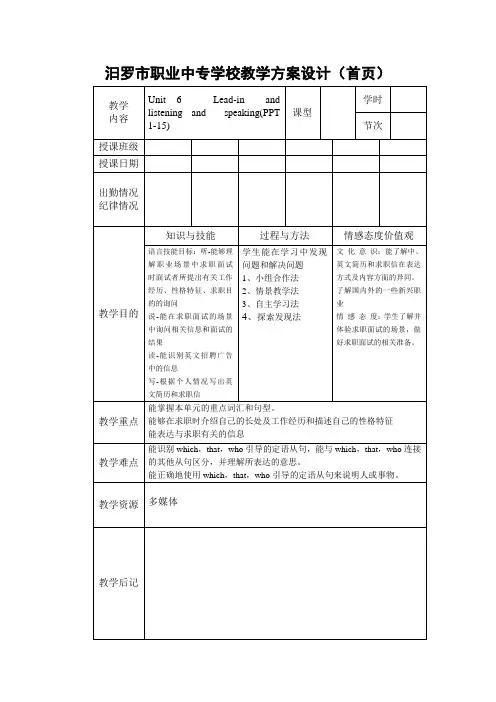
汨罗市职业中专学校教学方案设计(首页)Activity 5 Listen and complete 再听录音,补全以下句子。
1 Lin Dong will have ____________ tomorrow morning.2. Lin Dong once worked_______________________________.3. Lin Dong wants to work in the company because the company has ____________________.4. The company needs_______________.5. Lin Dong is a hardworking, __________ and ___________ boy. Activity 6 listen and underline 再听录音,用下画线标出在面试中可能用到的语句。
Step3 Practice and consolidationActivity 7 Ask and answer 两人一组,根据以下信息进行面试问答练习。
A: Would you mind …?B: I once worked in …A: Why do you want to work for our company?B: …A: Your application letter says …B: …A: We need … Do you have any questions?ApplicantPosition to apply for:salespersonPersonality:outgoing, cooperative and hardworking 程中抓住关键词。
可以让学生根据自己的情况填写一份求职者的信息表,然后同伴之间参照已有句型进行相互问答,模拟面试场景进行角色扮演。

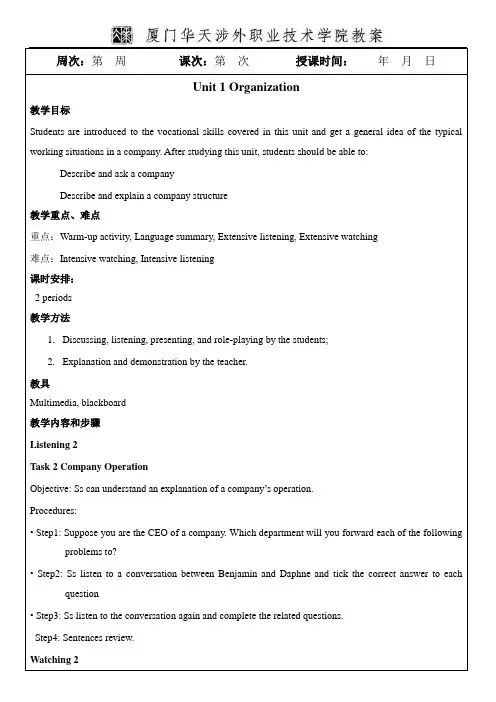
周次:第周课次:第次授课时间:年月日Unit 1 Organization教学目标Students are introduced to the vocational skills covered in this unit and get a general idea of the typical working situations in a company. After studying this unit, students should be able to:Describe and ask a companyDescribe and explain a company structure教学重点、难点重点:Warm-up activity, Language summary, Extensive listening, Extensive watching难点:Intensive watching, Intensive listening课时安排:2 periods教学方法1.Discussing, listening, presenting, and role-playing by the students;2.Explanation and demonstration by the teacher.教具Multimedia, blackboard教学内容和步骤Listening 2Task 2 Company OperationObjective: Ss can understand an explanation of a company’s operation.Procedures:• S tep1: Suppose you are the CEO of a company. Which department will you forward each of the following problems to?• Step2: Ss listen to a conversation between Benjamin and Daphne and tick the correct answer to each question• Step3: Ss listen to the conversation again and complete the related questions.Step4: Sentences review.Watching 2Task 1 Job DutyObjective:Ss can learn the skills of asking about and describing a job and its responsibilities.Procedures:• S tep1: Ss work in pairs. Write down proper department names according to the description.• Step2: Ss watch a video clip and match the people with their title.• Step3: Ss watch a video clip again and decide whether the statements are true or false.• Step4: Ss write a sentence describing responsibilities of a certain job following the examples given.Task 2 Company OperationObjective:Ss can learn the skills of describing and explaining a company’s operation.• S tep1: Ss work in pairs and brainstorm as many words or phrases as possible that can be used to describe positions• Step2: Ss watch a video clip and tick those departments that they’ve mentioned.• Step3: Ss watch a video clip again and decide whether the statements are true or false.• Step4: Ss read aloud sentences in Language Summary.Unit FileIntroduce the Business Notes to students课后作业:Finish the rest part of corresponding exercise课后小结:周次:第周课次:第次授课时间:年月日Unit 1 Organization教学目标Students are introduced to the vocational skills covered in this unit and get a general idea of the typical working situations in a company. After studying this unit, students should be able to:Describe a job and its dutyUnderstand and explain a company’s operation教学重点、难点重点:warm-up activity, language summary, extensive listening, extensive watching难点:Intensive watching, Intensive listening课时安排:2 periods教学方法3.Discussing, listening, reading, presenting, and role-playing by the students;4.Explanation and demonstration by the teacher.教具Multimedia, blackboard教学内容和步骤Speaking 2Objective: This part aims at guiding Ss to practice the skills they’ve learned in Listening 2 and Watching 2. • Step1: Ss work in pairs. Complete and practice conversation.• Step2: Ss work in pairs. Make up a conversation.• Step3: Ss work in pairs. Put each step of the production process into the correct place on the flowchart and describe the whole process to your partner in full sentences.• Step4: Ss work in groups. Work out a flowchart for a company and show its ordering, manufacturing and dispatch system.ProjectTask DescriptionStep 1: Organize a group of 4-6 students in class; Invent a company and work out the basic elements: name, business, headquarters, size, etc..Step 2: Discuss and work out the basic structure of the company. Elect one member as Chairman of the Board of the company; Work out rough job specifications for each position.Step3: Work together to draw a flowchart of the company’s operations; Choose one representative to show the chart to the whole class and describe how the company operates.Unit FileLanguage Focus & Cultural Notes课后作业:Finish the rest part of corresponding exercise课后小结:。
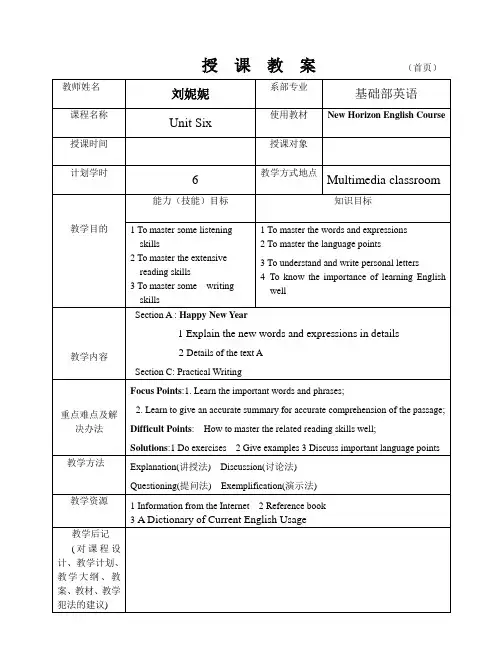
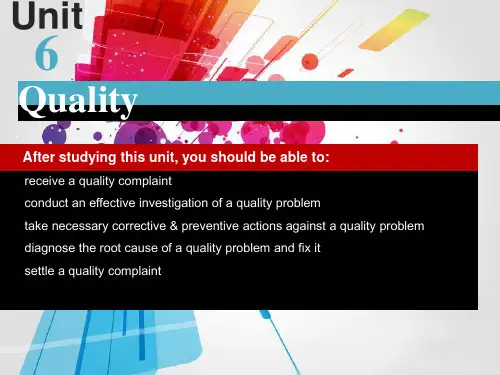
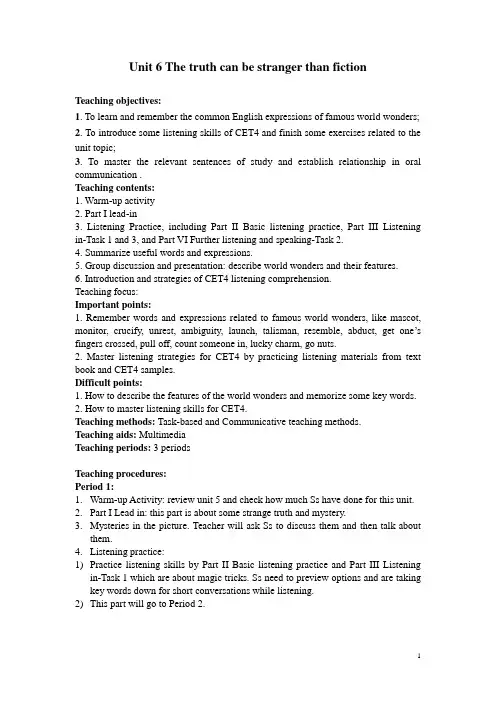
Unit 6 The truth can be stranger than fictionTeaching objectives:1. To learn and remember the common English expressions of famous world wonders;2. To introduce some listening skills of CET4 and finish some exercises related to the unit topic;3. To master the relevant sentences of study and establish relationship in oral communication .Teaching contents:1. Warm-up activity2. Part I lead-in3. Listening Practice, including Part II Basic listening practice, Part III Listening in-Task 1 and 3, and Part VI Further listening and speaking-Task 2.4. Summarize useful words and expressions.5. Group discussion and presentation: describe world wonders and their features.6. Introduction and strategies of CET4 listening comprehension.Teaching focus:Important points:1. Remember words and expressions related to famous world wonders, like mascot, monitor, crucify, unrest, ambiguity, launch, talisman, resemble, abduct, get one’s fingers crossed, pull off, count someone in, lucky charm, go nuts.2. Master listening strategies for CET4 by practicing listening materials from text book and CET4 samples.Difficult points:1. How to describe the features of the world wonders and memorize some key words.2. How to master listening skills for CET4.Teaching methods: Task-based and Communicative teaching methods.Teaching aids: MultimediaTeaching periods: 3 periodsTeaching procedures:Period 1:1.Warm-up Activity: review unit 5 and check how much Ss have done for this unit.2.Part I Lead in: this part is about some strange truth and mystery.3.Mysteries in the picture. Teacher will ask Ss to discuss them and then talk aboutthem.4.Listening practice:1)Practice listening skills by Part II Basic listening practice and Part III Listeningin-Task 1 which are about magic tricks. Ss need to preview options and are taking key words down for short conversations while listening.2)This part will go to Period 2.Period 21.Continue to practice listening skills: 2) Part III Listening in-Task and Part VIFurther listening and speaking-Task 2 which are about views on S uperstitions or real bad luck. Besides preview and key words, Ss also need to judge the speakers meanings by theirs tones.2.Teacher will summarize some useful words and expressions in the selectedlistening materials.3.Teacher will ask Ss to discuss what they have listened in groups and choose one ortwo candidates to express their ideas group by group.Questions which will be offered by teacher:1)How many mysteries do you know? Do you believe in them?2)Is there anybody around you who is superstitious? What’s your opinion aboutsuperstition?3)What would you do when you found something that cannot be explained by truthand science?Period 31.Teacher will introduce new strategies of listening comprehension of CET4,especially news listening and lecture listening.2.Listening practice:1)Take a whole test of the CET4 listening with new forms.2)Group work: surf the internet to find some frequent-use words of news listeningand share in the class.。

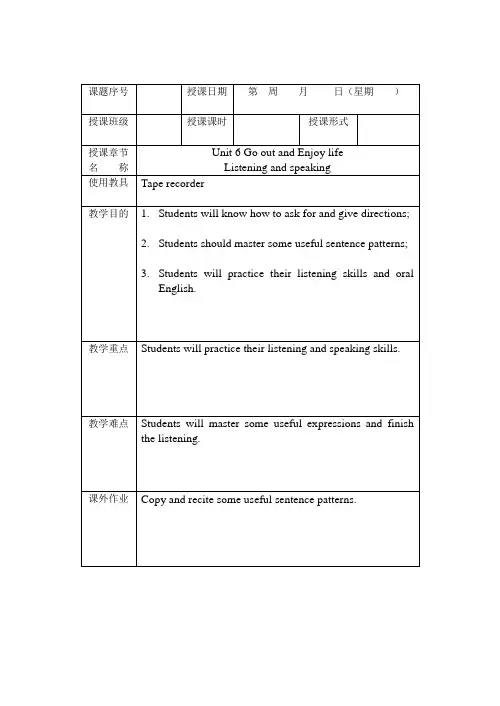
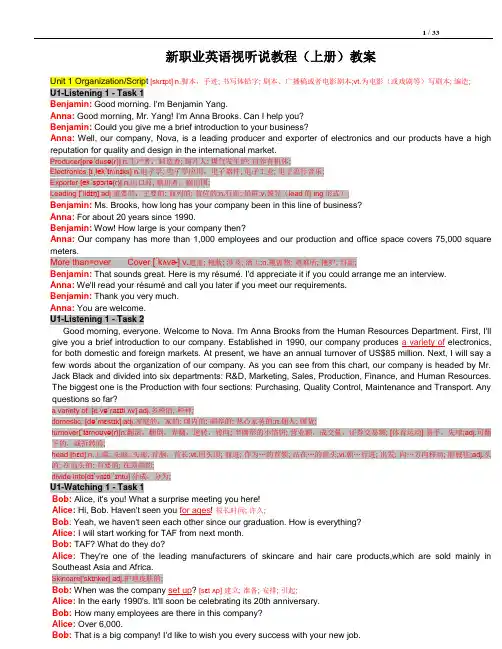
新职业英语视听说教程(上册)教案Unit 1 Organization/Script [skrɪpt]n.脚本,手迹; 书写体铅字; 剧本、广播稿或者电影剧本;vt.为电影(或戏剧等)写剧本; 编造;U1-Listening 1 - Task 1Benjamin: Good morning. I'm Benjamin Yang.Anna: Good morning, Mr. Yang! I'm Anna Brooks. Can I help you?Benjamin: Could you give me a brief introduction to your business?Anna: Well, our company, Nova, is a leading producer and exporter of electronics and our products have a high reputation for quality and design in the international market.Producer[prəˈdusə(r)] n.生产者,制造者; 制片人; 煤气发生炉; 自养有机体;Electronics [ɪˌlekˈtrɑnɪks]n.电子学; 电子学应用,电子器件; 电子工业; 电子流行音乐;Exporter [ekˈspɔrtə(r)] n.出口商; 输出者,输出国;Leading [ˈlidɪŋ]adj.重要的,主要的; 前列的; 首位的;n.行距; 铅框;v.领导(lead的ing形式);Benjamin: Ms. Brooks, how long has your company been in this line of business?Anna: For about 20 years since 1990.Benjamin: Wow! How large is your company then?Anna: Our company has more than 1,000 employees and our production and office space covers 75,000 square meters.More than=over Cover [ˈkʌvɚ]v.遮盖; 掩蔽; 涉及; 洒上;n.覆盖物; 避难所; 掩护; 封面;Benjamin: That sounds great. Here is my résumé. I'd appreciate it if you could arrange me an interview.Anna: We'll read your résumé and call you later if you meet our requirements.Benjamin: Thank you very much.Anna: You are welcome.U1-Listening 1 - Task 2Good morning, everyone. Welcome to Nova. I'm Anna Brooks from the Human Resources Department. First, I'll give you a brief introduction to our company. Established in 1990, our company produces a variety of electronics, for both domestic and foreign markets. At present, we have an annual turnover of US$85 million. Next, I will say a few words about the organization of our company. As you can see from this chart, our company is headed by Mr. Jack Black and divided into six departments: R&D, Marketing, Sales, Production, Finance, and Human Resources. The biggest one is the Production with four sections: Purchasing, Quality Control, Maintenance and Transport. Any questions so far?a variety of:[e vəˈraɪɪti ʌv]adj.多种的; 种种;domestic:[dəˈmɛstɪk]adj.家庭的,家的; 国内的; 驯养的; 热心家务的;n.佣人; 国货;turnover[ˈtɜrnoʊvə(r)]n.翻滚,翻倒,弄翻,逆转,转向; 半圆形的小馅饼; 营业额,成交量,证券交易额; [体育运动] 易手,失球;adj.可翻下的,或折转的;head [hɛd]n.上端; 头脑; 头部; 首脑,首长;vt.用头顶; 前进; 作为…的首领; 站在…的前头;vi.朝…行进; 出发; 向…方向移动; 船驶往;adj.头的; 在前头的; 首要的; 在顶端的;divide into[dɪˈvaɪd ˈɪntu]分成,分为;U1-Watching 1 - Task 1Bob: Alice, it's you! What a surprise meeting you here!Alice: Hi, Bob. Haven't seen you for ages! 很长时间; 许久;Bob: Yeah, we haven't seen each other since our graduation. How is everything?Alice: I will start working for TAF from next month.Bob: TAF? What do they do?Alice:They're one of the leading manufacturers of skincare and hair care products,which are sold mainly in Southeast Asia and Africa.Skincare['skɪnker] adj.护理皮肤的;Bob: When was the company set up? [sɛt ʌp] 建立; 准备; 安排; 引起;Alice: In the early 1990's. It'll soon be celebrating its 20th anniversary.Bob: How many employees are there in this company?Alice: Over 6,000.Bob: That is a big company! I'd like to wish you every success with your new job.Alice: Thank you! How about you, Bob? Do you still work for Otis Elevator?Bob: No, I've already left and started up my own business a year ago.Start up:[stɑrt ʌp](使)开始运转; 开始,着手;=runAlice: You're self-employed! That's marvelous! What line of business are you in?Self-employed:自营;个体经营的; self-service.marvelous [ˈmɑrvələs]adj.引起惊异的; 不可思议的; 非凡的; 神乎其神;Bob: I specialize in专攻,精通,以…为专业;专修importing and exporting chemical products.Alice: Fantastic! There might be chances for us to do business together.Bob: Definitely. This is my business card. Let's keep in touch.Alice: Sure.U1-Watching 1 - Task 2Alice: May I come in?Bill: Yes, come in, please.Alice: Good morning, Sir. My name is Alice Zhao. I'm a newcomer to Sales & Marketing Department.Newcomer [ˈnukʌmə(r)]n.新来的人; 新手; 新生事物;Bill:Good morning, Alice. Sit down, please. I'm Bill Smith, Manager of this department. Welcome to Sales & Marketing.Alice: Thank you, Mr. Smith.Bill: Just call me Bill. Have you reported to the Human Resources Department?Alice: Yes, Sir.Bill: Then, you've already got a brief introduction of our company?Alice: Yes, Mr. Smith. But I am a bit confused about the organizational structure.Bill: Well, it's not that complicated. Look at this organization chart.The company is headed by the Board of Directors董事会, which takes charge of company strategies and general policies. The Board usually appoints a CEO to take responsibilities for the company's daily operation.Complicate [ˈkɑmplɪkeɪt]vt.使复杂化; 使错综,使混乱; 使卷入; 变复杂;adj.复杂的; 麻烦的; (昆虫的翅)纵折的;Alice:Oh, I know Mr. Bruce Anderson is the CEO of our company. He was a business professor at a famous college before he joined our company.Bill: Yes. Our company is divided into five areas. They are: the R&D, the Sales & Marketing, the Production, the Finance, and the Human Resources.The biggest one is the Production Department. It has four sections: Purchasing, Quality Control, Transport and After-sales.Alice: What about our department then?Bill:Since our markets are mainly in Southeast Asia and Africa, our department is accordingly divided into two regional branches. Is that clear now?Accordingly[əˈkɔrdɪŋli]adv.因此,于是; 依据; 照着,相应地;Regional [ˈridʒənəl]adj.地区的,区域的; 特定区域的,特定地区的; 方言的; 区域性;Alice: Yes, very clear. Thank you.Unit 1 Organization / ScriptU1-Listening 2 - Task 1(Benjamin is chatting with another newcomer during the break.)Daphne: We have the Board of Directors, the CEO, and the shareholders. What are the differences between them? Shareholder [ˈʃerhoʊldə(r)]n.股东; 股票持有者;Benjamin: The shareholders own the company. They form the financial control system.Daphne: What does the CEO do?Benjamin: He is responsible for everything that happens in the company, acting as the official representative of the company. If there is only one person with absolute power in a company, everyone knows the power will go to the CEO.Act as[ækt æz]担当…,起…的作用; 充; 充当; 为;Representative[ˌrɛprɪˈzɛntətɪv]n.代表; 继任者; 议员; 类似物;adj.典型的; 有代表性的; 代议制的; 相当[类似](另一种属)的;Absolute [ˈæbsəˌlut]adj.绝对的,完全的; 不受任何限制[约束]的; 无条件的; 有无上权力或权威的;n.绝对; 绝对事物;Daphne: Isn't that too dangerous? Danerous adj. Danger n.Benjamin: You are right. That's the reason for having a Board of Directors. The Board is made up of a group of independent and unbiased people, to whom the CEO is responsible.Be made up of [bi med ʌp ʌv]由…组成;Independent [ˌɪndɪˈpɛndənt]adj.自主的; 不相关连的; 无党派的; 不相干的人所做的(或提供的);n.独立自主的人; 无党派人士;Unbiased [ʌnˈbaɪəst]adj.无偏见的,不偏不倚的,公正的; 持平; 无偏无党; 谠;Daphne: What does the Board of Directors do?Benjamin: They meet monthly, quarterly, or annually, providing long-term planning and vision, and acting as moralBenjamin: Yes, all the departments involved are busy with it now.Daphne: What departments are involved?Benjamin: Three departments: R&D, Production and Quality Control.Daphne: Teamwork again. How do they cooperate with each other?Benjamin: First, the R&D designs new products. The keyword in this phase is innovation.Daphne: Yes, that's why it takes a lot of effort, too.Benjamin:Then the Production comes in. As soon as the design proves feasible, the Production starts the assembly line and puts the design into real products.Feasible [ˈfizəbəl]adj.可行的; 可用的; 可实行的; 可能的;Daphne: How does the Quality Control collaborate with the other two?Collaborate [kəˈlæbəˌret]vi.合作,协作; (国家间的)协调,提携; 勾结,通敌; =cooperateCollaborate with[kəˈlæbəˌret wɪð]v.合作,与敌人合作,通敌;Benjamin: The QC takes random samples up to the lab for testing. Manufacturing problems are reported to the Production and design problems go to the R&D.Random [ˈrændəm]adj.任意的; 随机的; 胡乱的;n.随意; 偶然的行动;Daphne: I can see close cooperation among the three is the key to product quality.Benjamin: You're right.U1-Watching 2 - Task 1Bill: My name is Bill Smith. I'm the manager of Sales and Marketing at TAF. I'm responsible for sales and promotion of the company's products. Today I'm going to introduce to you my colleagues around the company. Here is my colleague, Alice. Today is actually her second day in our company and she's going to help me with this video. Come on, Alice! Here is Victoria. Hi, Vicky!Victoria: Hello, Bill.Bill: Please Vicky... Could you just give your name, your job title and a description of what you do?Victoria: Oh, is this for next week's trade fair? 商品交易会;Bill: Yes, we need to briefly introduce our company at the trade fair.Victoria: OK. Is your camera ready? My name is Victoria Song. I'm an assistant manager for international PR. I establish and maintain relationships with our overseas partners. PR(public relations)Bill: Thanks, Vicky... This is Dave, Manager of the Production Department. Hi,Dave!Dave: Hi, Bill. How's the preparation for the trade fair going?Bill: Actually, I'm working on it right now! Could you give your name, your title and a description of what you do? Dave:Sure. Hello, I am Dave from the Production Department. We are responsible for developing and manufacturing products.Bill: Thanks, Dave.U1-Watching 2 - Task 2Bill: Hi, Alice, how is it going so far?Alice:So far so good. Everything's interesting, except that n.除了…之外,只可惜the set-up here is still a little confusing—who's where and what's what.Bill: I see. Let me show you around and tell you how the company operates.Alice: You are always so nice!Bill: This way, please. Right there at the far end of the corridor on the right is the CEO's office. Have you met Mr.Alice: Not yet.Bill: Next to the photocopy room is the Finance Department. If you have any questions concerning your payment, you can come here.Concern [kənˈsɜrn]vt.涉及,关系到; 使关心,使担忧; 参与;n.关心; 关系,有关; 顾虑; 公司或企业;Alice: Payments for our products are handled here too, I guess.Bill: Yes. They offer us statistics about our sales performance as well. Opposite the Finance Department is the R&D Department. Requests and complaints from our clients shall be forwarded to them.Statistic[stəˈtɪstɪk]n.统计资料中的一项; 统计数据;统计量;(对总体具有代表性的)典型统计论;adj.统计(上)的,统计学(上)的;Alice: So, we'll cooperate a lot with the R&D.Bill: Right. Another department we often work with is the Production Department, next to the R&D. Orders from our clients will go to them.Alice: Are they responsible for dispatching and maintenance?Dispatch [dɪˈspætʃ]vt.派遣,调度; (迅速地)发出; 迅速处理,迅速了结; 处决(罪犯等);n.(使者等的)派遣; 急件; 迅速办理,快速处理; (记者发回的)新闻报道;Bill: Yes. The Transport Section and the After-sales Section handle those responsibilities.Alice: Thank you very much, Bill.Bill: By the way, if you have any trouble with your work, you can come to me. I'm the first person you can turn to for help. Turn to[tɚn tu](使)转向; (使)变成; 求助于; 翻书到;Unit 1 Organization / ScriptU1-Supplementary Listening - Task 1A: Where is H&M located?B: It's located in Texas, USA.A: How far is H&M from Scavo Town?B: It's about 70 km south of Scavo.A: What does the company produce?B: It produces tires. tire[taɪr]vt.使…疲惫; 使…厌烦;vi.厌烦; 疲劳;n.轮胎; 头饰; tie[taɪ]领带A: When was the company founded?B: It was founded in 1983.A:How many people work for H&M?B: More than 2,000 people work for it.U1-Supplementary Listening - Task 2A: My name is James Wilson, Business Manager of Sunshine Ltd. I've been with the company for nearly 11 years.It's my pleasure to introduce our company to you.B: Thank you, Mr. Wilson. Would you please tell me where your company is based?A: It is based in Dongguan, Guangdong Province, fairly central to the Pearl River Delta and close to Guangzhou.Fair[fer]adj.公平的; 合理的; 晴朗的; 美丽的;adv.公平地; 直接地; 清楚地; 正大光明地;n.集市,庙会; 商品交易会,展览会; 美人,美丽的事物;vt.(卡通制作)顺利接合; (动作)衔接协调; (飞机)装配平整; 使(飞机接合部)平滑;vi.转晴;Fairly [ˈferli]adv.适当,相当地; 公平地; 完全,简直; 清楚地;B: Oh, very good transport links. When was your company founded?Link [lɪŋk]n.环,节; [计算机]链接; 关联,关系;vt.连结; 挽住,勾住;vi.用环连接; 联系在一起;A: It was founded in 1983.B: What does your company mainly produce?A: Our main products are tires for cars and trucks, which are sold to countries and regions all over the world.B: Your company is doing a great job in this field. Thank you for giving me such a detailed introduction.U1-Supplementary Listening - Task 3When you walk through the main gate, you will see a neat, 4-storeyed building about 50 meters away. That is our Neat[nit]adj.整洁的,干净的; 灵巧的; 匀整的; 未搀水的; 4-storeyed:4层楼的office building where all executive departments are located. To the left of the office building is a workshop with five floors. The assembly line is on the first two floors. There, our workers are busy producing quality tires around the clock. There are two warehouses at the back of the workshop. One is for raw materials, and the other is for finished products. Beside the warehouses is a small building where maintenance staff work. They will be on the spot immediately if any machine breaks down. The yellow building on the right side of the office building is our canteen. It can cater for 2,000 people at the same time.on the spot :[ɑn ði spɑt]立刻; 当场; 在危险中; 处于负责地位;cater [ˈketɚ]vt.& vi.提供饮食及服务;vt.满足需要,适合; 投合,迎合;n.(骰子,纸牌的)四点;cater for [ˈketɚ fɔr]提供饮食及服务; 迎合;U1-Supplementary Listening - Task 4Our company specializes in organizing cultural events and language courses. With 40 employees, it is small in size, but quite complete in structure. The Managing Director is in charge of the whole organization including four departments: Science, English Language, Arts and Finance. The department managers report to the Managing Director总经理 directly. The English Language Department has two sections. One is the Cultural Section, dealing with various cultural events related to English, and the other is the Examination Section, where language exams and courses are set up. The Arts Department also has two sections—the Exhibition Section and the Library. The Finance Department is mainly responsible for managing company accounts and paying salaries. As our company is quite small, we don't have a team leader in each section but everyone works hard.U1-Supplementary Listening - Task 5A: Good morning, Mr. Lee. I'm Helen Grey. I'd like to give you a general picture of our company structure.General [ˈdʒɛnərəl]adj.大致的; 综合的; 总的,全体的; 普遍的;n.上将; 一般; 一般原则; 常规;B: Thank you, Ms. Grey.A: First, we have a Board of Directors. Philip Dickson is the Chairman, and Anne Roberts is the Managing Director, who reports directly to Mr. Dickson.B: How many departments are there in the company?A:Four in all: Production, Marketing, Finance and Personnel. David Peters is the Production Manager, Fiona Harris is the Marketing Manager, and Mark Taylor, head of the Finance.Personnel [ˌpɜrsəˈnel]n.全体员工; (与复数动词连用)人员,员工; 人事部门;B: How about the Personnel Department?A:Led(lead的过去式和过去分词) by Nina Smith, the Department has two sections: Recruitment[rɪˈkrutmənt]and Training. Paul Rees is the Recruitment Manager and I am responsible for training. LedB: Oh, I see. Thank you very much, Ms. Grey.A: My pleasure. Hope you enjoy working here.Unit 2 Office / ScriptU2-Listening 1 - Task 1Jack: Well, Mr. Anderson, I was wondering if I could come and meet you at 3 p.m. next Monday.Bruce: Sorry, Mr. Black. I am afraid I have another appointment at that time.Jack: Then how about next Tuesday?Bruce: I am afraid I might be attending an opening ceremony in the morning and going to a conference in the afternoon. May be=maybeCeremony [ˈserəmoʊni]n.典礼,仪式; 礼仪,礼节; 虚礼,客气;Jack: Is Wednesday OK for you?Bruce: I'll be leaving for Shanghai next Wednesday and probably won't be back until Friday afternoon. Look, why don't I call you back and set the time later? Leave for 而不是leave toJack: OK, let me tell you my telephone number.Bruce: Oh, I have already got your number.Jack: Good, when can I expect your call then?Bruce: Maybe in a week or so. 大约; 左右; 把;Jack: I'll look forward to your call.U2-Listening 1 - Task 2Bill:Alice, have you found the files I asked for? Mr. Anderson needs those files before his meeting with Jack Black.Alice: Sorry, Bill. I couldn't find any information on Jack Black. Maybe we don't have the files in our department. Bill: I am quite sure that the information was filed. Do you know we use the alphabetical filing system?我很确定信息是归档的。
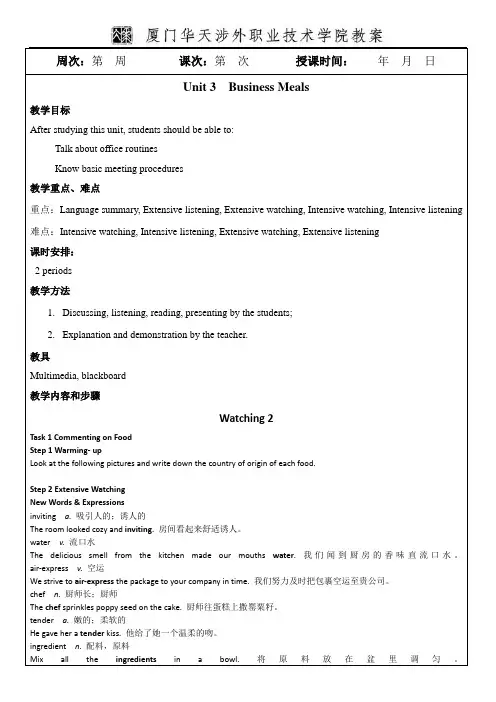
周次:第周课次:第次授课时间:年月日Unit 3 Business Meals教学目标After studying this unit, students should be able to:Talk about office routinesKnow basic meeting procedures教学重点、难点重点:Language summary, Extensive listening, Extensive watching, Intensive watching, Intensive listening 难点:Intensive watching, Intensive listening, Extensive watching, Extensive listening课时安排:2 periods教学方法1.Discussing, listening, reading, presenting by the students;2.Explanation and demonstration by the teacher.教具Multimedia, blackboard教学内容和步骤Watching 2Task 1 Commenting on FoodStep 1 Warming- upLook at the following pictures and write down the country of origin of each food.Step 2 Extensive WatchingNew Words & Expressionsinviting a.吸引人的;诱人的The room looked cozy and inviting. 房间看起来舒适诱人。
water v.流口水The delicious smell from the kitchen made our mouths water. 我们闻到厨房的香味直流口水。

Unit 6 Shopping and sightseeingAims of this unit:1. Improve listening and speaking skills2. Learn the words and phrases in the text3. Complete the exercises after the text4. Applied WritingFirst Two hours:Talking Face to Face & Being All EarsSection I Talking Face to Face1. Duty report3. Leading-in:Shopping adsSellers and manufacturers place a variety of shopping ads in newspapers and magazines, on the radio and television, to promote sales.Oral practice:1. Ask the students to say something about their impression on ads.2. Ask the students to write an ad to a newspaper to ask for an apartment.3. Ask the students to find a suitable restaurant from the newspaper.4. You want to buy some tri-colored glazed pottery at an arts and crafts shop.5. You are looking for a shirt of good quality at a Men’s Wear Department.6. You want to buy a computer and ask for a discount.4. Follow the Samples; read dialogues in roles (group work) Language points:date back 回溯至on sale 待售, 出售, 上市[美]廉价出售, 拍卖take your time 从容不迫5. Try to find useful patterns in the dialogues and translate them into Chinese, make up more sentencesUseful sentences:Some useful sentences:Excellent after-sales serviceFair prices to every customerChinese handicraftsDo you have anything particular in mind?I want to buy some souvenirs for my friends and relatives.How do you like this ring?Look around and see if you can find something you like. How about the tri-colored glazed pottery in Tang style?It’s very pleasing to the eye.What’s that in dollars?an arts and crafts shopI’d like a pair of leather shoes.What size, please?Anything I can do for you, sir?What brand do you need, please?This brand’s at 25 percent discount.More patterns and expressions for students to remember: We deal in TV sets, radios and the like.我们经营电视机、收音机以及诸如此类的商品。
Unit 6 Home Sweet HomeI. Teaching AimsBy learning this unit, the student should be able to describe home and house in English fluently.In this unit, students will be able to:1. Listen for the main idea and the key information of every passage;2. Grasp the language points and grammatical structures ;3. Learn to talk about home, houses and apartments;4. Arouse Ss interests for the topic of this unit and participate actively.II. Teaching important points1. Lesson A Speaking, Communication2. Topic understanding and content understanding of each passage3. Improving the students' listening and speaking abilityIII. Teaching difficult points1. Lesson B Video Course2.Speaking with logical thinking3.vocabulary about home, houses and apartments.IV. Teaching Methods1. Task-based teaching in while-listening procedure2. Listening and practicing3. Speaking and communication4. Media instruction5. Communicative Methods: answering, discussion, presentation, team work...V. Teaching hours10 class periodsVI. Teaching Procedures1.Lead-in / Warming upTry to describe your sweet home like the examples.2. Lesson A : Vocabulary Link1. Direct Ss’ attention to the pictures. Present the vocabulary. Have them read the sentences and number the pictures. Match each word with a place in the apartment. Check answers.2. Have Ss work in pairs. If there is one student left, ask him or her to join a pair to make a group. Imagine that you have your own apartment or house. Describe it to your partner. Have Ss create more conversations. Invite one or two pairs to give a demonstration to the class.3. Lesson A : Listening(1). Apartment huntingFamiliarize Ss with the new words. Have them read the new words aloud after you. Explain the task. Play the recording. Check answers.Tell Ss to listen again and mark their answers. Play the recording. Check answers.Introduce the topic that The man talks about three apartments. Number the apartments 1 to 3 as you listen. Have Ss listen and fill in the blanks with words they hear. Play the recording. Check answers. Have Ss read through the questions and possible answers. Tell Ss to listen again and check the correct boxes. Play the recording. Check answers.(2). A housing problemIntroduce the topic :Listen to Graciela talk to an adviser at her school. Then answer the questions. Then tell them to listen and number the steps in order. Play the recording. Check answers.Tell Ss to listen again and answer the questions. Play the recording. Check answers.(3). The Davis family wants a new home.Tell Ss they are going to listen to the program “Places for rent.”. Direct Ss’attention to the picture and ask them to read the questions. Tell Ss to listen and answer the questions. Play the recording. Check answers.Tell Ss to listen again and fill in the blanks with the words in the box. Play the recording. Check answers.(4). Make yourself at home!Introduce the topic. Tell Ss they are going to listen to a passage. Tell Ss to listen carefully and write short answers to the questions. Play the recording.Check answers. Have Ss look at the pictures carefully. Tell them to listen to the recording and number the pictures to match them with the explanations. Play the recording. Check answers.Tell Ss to listen again and fill in the blanks with the words they hear. Play the recording. Check answers.(5). Object-shaped housesDirect Ss’attention to the title. What will they hear? Present the new words and have Ss read aloud after you. Answer any questions about vocabulary.With the class, go over the list of questions. Tell Ss to listen and number the questions in the order they are asked during the interview. Play the recording. Check answers.Have Ss read the statements. Explain that all these statements are false. Tell Ss to listen again and correct the statements. Play the recording. Check answers.Tell Ss to listen again and write answers to the questions. Play the recording. Check answers.4. Lesson A : Pronunciation1. Remind students rising intonation to show surprise. Play the recording. Have Ss work in pairs to practice the conversations.2. Have Ss listen and read the sentences. Play the recording. Ask Ss to work in pairs to read the sentences. Check their pronunciation..5. Lesson A : Speaking and communicationActivity One1. Introduce the situation. How many rooms are there? Ask Ss to listen and fill in the blanks with the words they hear. Play the recording.Check answers.2. Put Ss in groups of three. Present the conversations again. Ask Ss to listen and read along in their groups. Play the recording again. Ask Ss to practice the conversations in groups. Remind Ss to keep eye contact with their group members while speaking.3. Ask Ss to work in groups of three. Ask Ss to read the model conversation. Answer any questions about vocabulary. If necessary, play the recording. Elicit or explain to Ss who the famous celebrities are.4. Have Ss work in groups of three. Each student should role-play a famous person. Have Ss work in their groups to create and practice a new conversation where they introduce each other. When all groupsActivity Two1. Have Ss work individually to write three sentences about themselves, and another three sentences about themselves.2. Collect and redistribute the papers.Pair work: Introduce the topic. Look at the pictures of this famous house. Use three adjectives to describe the house. Share your ideas with the class.Have Ss read the information. Ask Ss to discuss the events in pairs.6. Lesson B: Video Course Student housingGlobal Viewpoints Where I live1. Say the list of vocabulary items aloud as Ss repeat for pronunciation practice. If necessary, explain the meaning of the words. Have Ss complete the sentences using the correct words from the New words. Check answers.2. Explain to Ss that they are going to watch several people talking about student housing. Before viewing, have Ss read the statements so they know what to watch and listen for. Ask Ss to watch and circle True if the statement is completely correct. If it is False, they must listen for information to correct for it. Play the video. Check answers.3. Tell Ss they will watch the interviews. Ask Ss to fill in the missing words as they watch the video. Play the video. Check answers.7. Lesson B:City Living Mike needs a changeIntroduce the main and minor characters to Ss.1.Introduce the situation. In this video, we learn how Mike and Takeshi became roommates.2. Have Ss use the information from the pictures and captions to complete the sentences. Check answers.8. Lesson B:City Living Mike needs a change “While You Watch”1. Before viewing, have Ss read the sentences so they know what to watch and listen for. Ask Ss to watch and then match the sentence parts to make true sentences. Play the video. Check answers.2. Give Ss time to study the pictures and sentences. Tell Ss: What’s the story? Watch the video. Choose the correct words to complete the sentences.Play the video and allow time for Ss to answer. Check answers.3. Give Ss time to study the pictures and questions. Ask Ss to pay attention to what people say in the video. Play the first episode of the video. Check answers.4. Give Ss time to study the pictures and questions. Ask Ss to pay attention to what people say in the video. Play the second episode of the video and allow time for Ss to fill in the blanks. Check answers.Class work: Show the script of the second episode of the video on the screen.Explain that some of the words are missing. Play the 2nd episode and ask Ss to act out the lines of the script as a class. Check answers.5. Give Ss time to study the pictures and script. Play the third episode of the video and allow time for Ss to fill in the blanks. Check answers.6. Give Ss time to study the question. Play the whole video once again and allow time for Ss to answer. Check answers.9. Lesson B:City Living Mike needs a change “After You Watch”1. Read the useful expressions dialogues aloud, emphasizing the expressions in blue. Encourage students to think of how the phrases were used in the video before matching the expressions to the definitions. The teacher checks the answers.2. Read the examples given from the video. Have Ss fill in the blanks with the correct forms of the verbs in brackets. Check answers.3. Ask Ss to write a short summery of the City Living story.VII. Assignments1.Review: Oral practice: to describe home and house (pair work)2. Learn the key words and expressions by heart.3. Role-play some conversations.4. Write a short summary of the City Living story.5. Talk about home, houses and apartments.。
周次:第周课次:第次授课时间:年月日
Unit 6 Transportation
教学目标
After studying this unit, students should be able to:
Tracking the shipment
Checking the Goods
教学重点、难点
重点:Language summary, Extensive listening, Extensive watching, Intensive watching, Intensive listening 难点:Intensive watching, Intensive listening, Extensive watching, Extensive listening
课时安排:
2 periods
教学方法
1.Discussing, listening, reading, presenting by the students;
2.Explanation and demonstration by the teacher.
教具
Multimedia, blackboard
教学内容和步骤
Listening 2
Task 2 Tracking the shipment
Objective: Ss can express their viewpoints on tracking the shipment.
Procedures:
• S tep1: Warming-up. Describe the meaning of the following shipping labels in your own words.
• Step2: Ss listen to a conversation between Jack and Bill and decide whether the statements are true or false.
• Step3: Ss listen to the conversation again and tick the correct answer to each question.
Step4: Language summary, read aloud the following sentences about tracking the shipment .
Watching 2
Task 1 Checking the Goods
Objective:
Ss can understand and Check the Goods
Procedures:
• S tep1: Warming-up. Put the following words into the right categories and try to brainstorm.
• Step2: Ss watch a video clip and decide whether the following statements are T\F.
• Step3: Ss watch a video clip again and answer the questions.
• Step4: Language summary Read aloud the following sentences talking about goods damage.
Task 2 Dealing with Disputes
Objective:
Ss can talk about dealing with disputes
• S tep1: Ss brainstorm as many qualities as they can about dealing with disputes.
• Step2: Ss watch a video clip and tick those that are covered in their talk.
• Step3: Ss watch a video clip again and answer the questions.
• Step4: Language Summary.Ss read aloud the sentences about dealing with disputes.
Supplementary Listening
课后作业:
Finish the rest part of corresponding exercise
课后小结:
周次:第周课次:第次授课时间:年月日
Unit 6 Transportation
教学目标
After studying this unit, students should be able to:
Talk about the problem concerning shipment
Talk about the insurance of goods
Describe the damages of goods
Negotiate to deal with disputes
教学重点、难点
重点:Language summary, Speaking
难点:Speaking, Supplementary Listening
课时安排:
2 periods
教学方法
1. Discussing, listening, reading, presenting, and role-playing by the students;
2. Explanation and demonstration by the teacher.
教具
Multimedia, blackboard
教学内容和步骤
Speaking 2
Objective: This part aims at guiding Ss to practice the skills they’ve learned in Listening 2 and Watching 2. • Step1: Work in pairs. Complete the description of the process of insuring shipment orally.
• Step2: Ss work in groups. Put the steps into the right order and retell the process to your partner.
• Step3: Ss work in groups. Complete practice the conversation according to the given information
• Step4: Ss work in groups. You are going to have a negotiation about the goods damage with your business partner. Try to hold your position and make the other side to compromise.
Project
Step1: Organize a group of 4-6 students to form the Organizing
Sub-divide the group into 2 small groups: the exporting group and the importing group.
The 2 groups discuss together and decide on the packing of goods, the mode and date of shipment
Step 2: As one third of the goods are damaged, both groups have a discussion within the groups to set the bottom line as well as strategies for the coming negotiation. The 2 groups talk about the damages of goods and reach agreement on how to sole the disputes.
Unit File
Language Focus & Cultural Notes
Supplementary Listening
课后作业:
Finish the rest part of corresponding exercise
课后小结:。